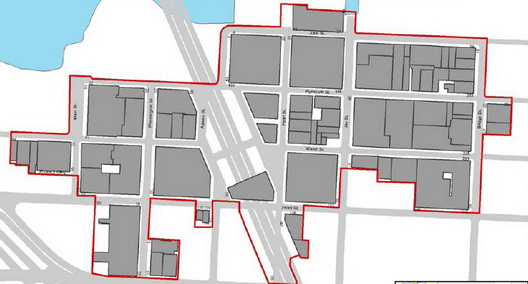
The New York City Landmarks Preservation Commission voted 8-0 yesterday to create a Dumbo Historic District. The unanimous voted capped a long effort to create the district. The boundaries are John Street to the north, York Street to the south, Main Street to the west and Bridge Street to the east. The district includes 91 buildings “that represent important industrial design trends in the United States and the City in the 19th and early 20th centuries,” in the words of a release from the LPC. Landmarks Chair Robert B. Tierney said:
DUMBO was essential to Brooklyn’s rise as a major manufacturing center, and was home to some of America’s most important industrial firms that produced everything from ale and paper boxes to soap and steel wool. DUMBO’s distinctively designed buildings and sublime vistas survive to this day, and still define its character, even as it has evolved into a largely residential neighborhood. This designation will ensure that this still-evolving neighborhood retains its unique historic character.
Some of the significant buildings that are protected include:
20 Jay Street. Erected for Arbuckle Brothers in 1909. Designed by William Higginson Arbuckle Brothers was America’s largest coffee roaster and packager, as well as a sugar refiner. The sugar refinery and several other Arbuckle buildings are within the historic district. In 1913, Arbuckle employed 100 people in its coffee business and 668 in its sugar refinery.
135 Plymouth Street. Built 1901 for E.W. Bliss. Designed by RL Daus. E. W. Bliss was a major machinery manufacturer that employed 1,646 people. It this was the second largest machinery manufacturer in Brooklyn in 1913, behind the Merganthaler Company.
26-38 Washington Street. Constructed for Robert Gair Co. in 1887. Designed by Benjamin Finkensieper. Robert Gair Co. manufactured paper boxes and printed labels, stationery, and other items. Gair was also a major realtor, leasing industrial space in his many buildings within the Historic District. In 1913, Gair employed 1,702 people.
Of course, having a Dumbo Historic District in place several years ago would have been helpful in terms of having an impact on some big developments, nonetheless, it is a very important step.
Dumbo Historic District Linkage:
- Breaking: Dumbo Designated as Landmark District [Brownstoner]
- Dumbo Landmarked, Including Its ‘Sublime Vistas’ [TRE]
- LPC Approves DUMBO Historic District [Gothamist]
- Dumbo is Now Protected as a Historic District [CityRoom]
- LPC Approves Dumbo Historic District [Dumbo NYC]
- DUMBO Area Gets Landmarked [Sun]
